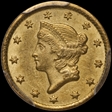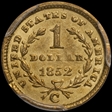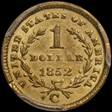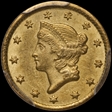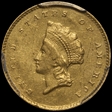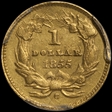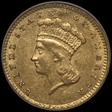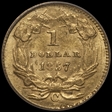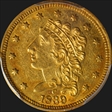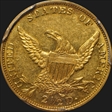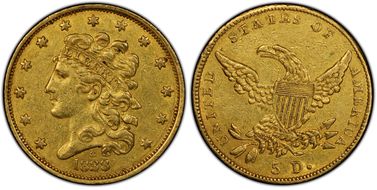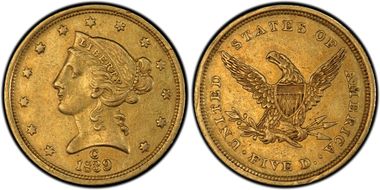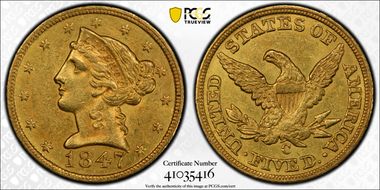Overland Trail Collection 的钱币相册
The 1852-c gold dollar is one of the two most common from this mint but is much harder to locate than its counterpart the 1851-c. Most 52-c dollars are seen in EF45-AU53 grades and nice AU specimens with natural color and surfaces are difficult to locate. This very pleasing slider example shows natural deep green-gold toning on obverse and reverse. The flatness of strike and some cabinet friction on this piece has limited the grade to AU58. On the reverse there is a mint-made planchet depression through the LA of Dollar. (per Douglas Winter)
The 1852-c gold dollar is one of the two most common from this mint but is much harder to locate than its counterpart the 1851-c. Most 52-c dollars are seen in EF45-AU53 grades and nice AU specimens with natural color and surfaces are difficult to locate. This very pleasing slider example shows natural deep green-gold toning on obverse and reverse. The flatness of strike and some cabinet friction on this piece has limited the grade to AU58. On the reverse there is a mint-made planchet depression through the LA of Dollar. (per Douglas Winter)
The 1852-c gold dollar is one of the two most common from this mint but is much harder to locate than its counterpart the 1851-c. Most 52-c dollars are seen in EF45-AU53 grades and nice AU specimens with natural color and surfaces are difficult to locate. This very pleasing slider example shows natural deep green-gold toning on obverse and reverse. The flatness of strike and some cabinet friction on this piece has limited the grade to AU58. On the reverse there is a mint-made planchet depression through the LA of Dollar. (per Douglas Winter)
The 1852-c gold dollar is one of the two most common from this mint but is much harder to locate than its counterpart the 1851-c. Most 52-c dollars are seen in EF45-AU53 grades and nice AU specimens with natural color and surfaces are difficult to locate. This very pleasing slider example shows natural deep green-gold toning on obverse and reverse. The flatness of strike and some cabinet friction on this piece has limited the grade to AU58. On the reverse there is a mint-made planchet depression through the LA of Dollar. (per Douglas Winter)
The 1855-C is numismatically significant as the only Type Two gold dollar from the Charlotte mint. It is also one of only two one-year types from this mint along with the 1839-C half eagle. The 55-C gold dollar is seen most often in EF40 to AU50 and properly graded AU53 coins are scarce. This example is better struck than usual and is found on an above-average quality planchet. As with many examples, there are clashmarks and some areas of roughness but the natural green-gold surfaces are more solid and eye appealing than usual for the issue. The date and mintmark are bold and the borders show nearly full detail. (per Doug Winter)
The 1855-C is numismatically significant as the only Type Two gold dollar from the Charlotte mint. It is also one of only two one-year types from this mint along with the 1839-C half eagle. The 55-C gold dollar is seen most often in EF40 to AU50 and properly graded AU53 coins are scarce. This example is better struck than usual and is found on an above-average quality planchet. As with many examples, there are clashmarks and some areas of roughness but the natural green-gold surfaces are more solid and eye appealing than usual for the issue. The date and mintmark are bold and the borders show nearly full detail. (per Doug Winter)
The redesign of the gold dollar did little to improve the quality of the 1857 issue as it is one of the poorest manufactured coins ever issued by a U. S mint. Most specimens are made with inferior dies and badly produced planchets. Virtually all examples exhibit weak, incomplete strikes with flat to little lustre. The present example is one of the better produced coins with a fairly good strike with some lustre enhanced by golden toning in the fields. This is about as attractive as this issues gets, which isn't saying much.
The redesign of the gold dollar did little to improve the quality of the 1857 issue as it is one of the poorest manufactured coins ever issued by a U. S mint. Most specimens are made with inferior dies and badly produced planchets. Virtually all examples exhibit weak, incomplete strikes with flat to little lustre. The present example is one of the better produced coins with a fairly good strike with some lustre enhanced by golden toning in the fields. This is about as attractive as this issues gets, which isn't saying much.
The redesign of the gold dollar did little to improve the quality of the 1857 issue as it is one of the poorest manufactured coins ever issued by a U. S mint. Most specimens are made with inferior dies and badly produced planchets. Virtually all examples exhibit weak, incomplete strikes with flat to little lustre. The present example is one of the better produced coins with a fairly good strike with some lustre enhanced by golden toning in the fields. This is about as attractive as this issues gets, which isn't saying much.
The 1839-C is one of two quarter eagle dates of the Classic design possessing the obverse "C" mint mark above the date. This coin has a nice green gold coloration combined with an early die state strike thus avoiding the numerous die cracks of later states. Luster abounds with some golden accents especially on the obverse. A rare coin with only a few graded higher
The 1839-C is one of two quarter eagle dates of the Classic design possessing the obverse "C" mint mark above the date. This coin has a nice green gold coloration combined with an early die state strike thus avoiding the numerous die cracks of later states. Luster abounds with some golden accents especially on the obverse. A rare coin with only a few graded higher
This first year type has exceptional smooth, nick-free, original surfaces, very uncharacteristic for the issue. Some luster still resides under the deep green-gold toning. A most attractive Charlotte specimen.
The most common Charlotte Half Eagle, but rare in mint state. This specimen has deep green-gold coloration with flashy satin luster and few nicks or imperfections.




















